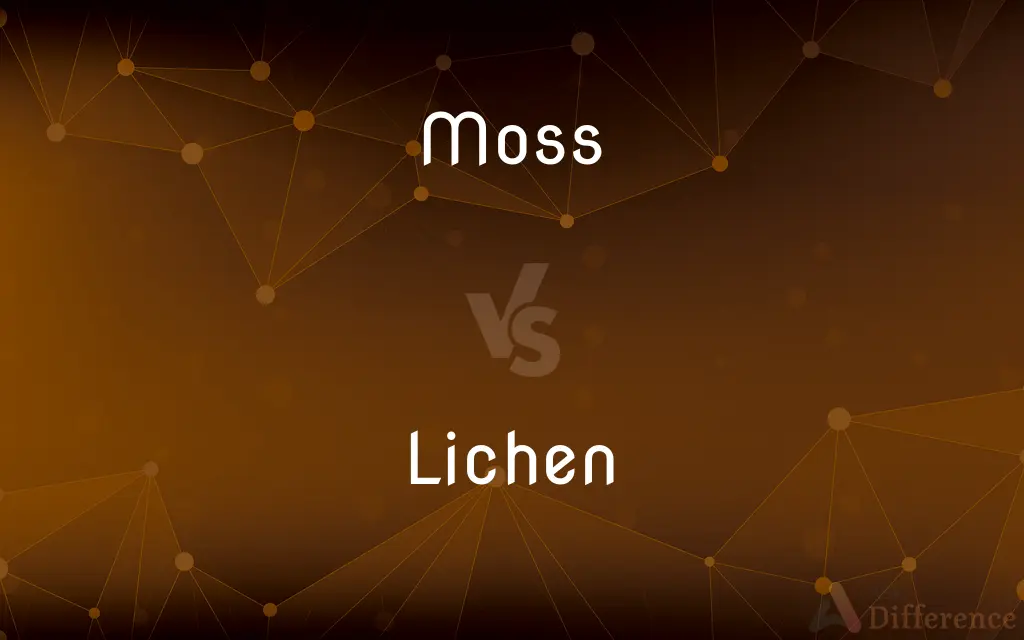Moss vs. Lichen — What's the Difference?
By Tayyaba Rehman — Updated on September 22, 2023
Moss is a small, green, non-vascular plant, while Lichen is a composite organism formed from a fungus and an alga or cyanobacterium living together symbiotically.

Difference Between Moss and Lichen
Table of Contents
ADVERTISEMENT
Key Differences
Moss and Lichen both frequently adorn surfaces like rocks and trees, but they are fundamentally different. Moss belongs to the bryophyte family, characterized by its small green leaves and non-vascular nature. These plants obtain water through direct absorption. Lichen, on the other hand, isn't a plant at all. It's a partnership between a fungus and either an alga or a cyanobacterium, living in a symbiotic relationship.
In their habitats, while Moss usually prefers damp or shady locations, Lichen is incredibly resilient, able to survive in some of the most extreme environments, from arctic tundras to parched deserts. This is because Lichen derives nutrients from its symbiotic partner, which can photosynthesize, and from minerals it extracts from substrates.
The physical appearance of Moss and Lichen is also distinct. Moss often appears plush, with tiny leaf-like structures. Lichen, conversely, can exhibit various forms, including crusty patches, leafy projections, or intricate branching patterns. This diversity in Lichen is a result of its dual nature and the varied relationships between its constituent organisms.
While both Moss and Lichen play vital ecological roles, such as soil formation and providing food sources for animals, they differ in their reproductive methods. Moss reproduces via spores, while Lichen propagates through a combination of both the fungal and algal/cyanobacterial components.
Comparison Chart
Nature
Plant (Bryophyte)
Symbiotic partnership (fungus & alga/cyanobacterium)
ADVERTISEMENT
Preferred Environment
Damp or shady areas
Varies, including extreme environments
Appearance
Small green leaves, plush appearance
Crusty, leafy, or branched forms
Role
Soil formation, water retention, food source
Soil formation, nitrogen fixation, food source
Reproduction
Through spores
Through combined fungal and algal/cyanobacterial components
Compare with Definitions
Moss
A primitive plant reproducing through spores.
The Moss released its spores in the wind.
Lichen
Plays a role in nitrogen fixation in ecosystems.
Lichen contributed to the soil's fertility.
Moss
Plants that lack true roots, stems, or flowers.
Moss absorbed water directly from raindrops.
Lichen
Symbiotic relationship surviving in varied environments.
In the desert, Lichen clung to rocks and soil.
Moss
Ground cover often found in damp areas.
The forest floor was soft with Moss.
Lichen
A lichen ( LY-ken or, sometimes in the UK, , LICH-en) is a composite organism that arises from algae or cyanobacteria living among filaments of multiple fungi species in a mutualistic relationship. Lichens have properties different from those of their component organisms.
Moss
A bryophyte with tiny leaf-like structures.
Moss thrived on the shady side of the tree.
Lichen
A composite organism made up of a fungus, usually an ascomycete, that grows symbiotically with an alga or a cyanobacterium and characteristically forms a crustlike or branching growth on rocks or tree trunks.
Moss
Mosses are small, non-vascular flowerless plants in the taxonomic division Bryophyta (, ) sensu stricto. However, Bryophyta (sensu lato, Schimp.
Lichen
(Medicine) Any of various skin diseases characterized by patchy eruptions of small, firm papules.
Moss
A small flowerless green plant which lacks true roots, growing in low carpets or rounded cushions in damp habitats and reproducing by means of spores released from stalked capsules
The bog is home to rare mosses
The trees are overgrown with vines and moss
Lichen
To cover with lichens.
Moss
A green colour like that of moss.
Lichen
Any of many symbiotic organisms, being associations of algae and fungi, often found as white or yellow-to-blue–green patches on rocks, old walls, etc.
Moss
A bog, especially a peat bog.
Lichen
(figurative) Something which gradually spreads across something else, causing damage.
Moss
Cover with moss
The mossed old trees
Lichen
One of a class of cellular, flowerless plants, (technically called Lichenes), having no distinction of leaf and stem, usually of scaly, expanded, frond-like forms, but sometimes erect or pendulous and variously branched. They derive their nourishment from the air, and generate by means of spores. The species are very widely distributed, and form irregular spots or patches, usually of a greenish or yellowish color, upon rocks, trees, and various bodies, to which they adhere with great tenacity. They are often improperly called rock moss or tree moss.
Moss
Any of various green, usually small, nonvascular plants of the division Bryophyta, having leaflike structures arranged around the stem and spores borne in a capsule.
Lichen
A name given to several varieties of skin disease, esp. to one characterized by the eruption of small, conical or flat, reddish pimples, which, if unchecked, tend to spread and produce great and even fatal exhaustion.
Moss
A patch or covering of such plants.
Lichen
Any of several eruptive skin diseases characterized by hard thick lesions grouped together and resembling lichens growing on rocks
Moss
Any of various other unrelated plants having a similar appearance or manner of growth, such as Irish moss, Spanish moss, and the club mosses.
Lichen
Any thallophytic plant of the division Lichenes; occur as crusty patches or bushy growths on tree trunks or rocks or bare ground etc.
Moss
To cover with moss.
Lichen
A composite organism of fungus and alga/cyanobacterium.
Lichen dotted the surface of the old stone wall.
Moss
Any of various small, green, seedless plants growing on the ground or on the surfaces of trees, stones, etc.; now specifically, a plant of the phylum Bryophyta (formerly division Musci).
Lichen
Organism that can photosynthesize and extract minerals.
Lichen on the tree bark indicated clean air.
Moss
(countable) A kind or species of such plants.
Lichen
Exhibits diverse forms, from crusty to leafy.
The colorful Lichen patterns caught her eye.
Moss
(informal) Any alga, lichen, bryophyte, or other plant of seemingly simple structure.
Spanish moss
Irish moss
Club moss
Moss
A bog; a fen.
The mosses of the Scottish border
Moss
(intransitive) To become covered with moss.
An oak whose boughs were mossed with age.
Moss
(transitive) To cover (something) with moss.
Moss
A cryptogamous plant of a cellular structure, with distinct stem and simple leaves. The fruit is a small capsule usually opening by an apical lid, and so discharging the spores. There are many species, collectively termed Musci, growing on the earth, on rocks, and trunks of trees, etc., and a few in running water.
Moss
A bog; a morass; a place containing peat; as, the mosses of the Scottish border.
Moss
To cover or overgrow with moss.
An oak whose boughs were mossed with age.
Moss
Tiny leafy-stemmed flowerless plants
Moss
A small non-vascular green plant.
The rock was covered with Moss.
Common Curiosities
Is Lichen a sign of air quality?
Yes, certain types of Lichen can indicate clean air, as they're sensitive to pollutants.
Can Lichen grow in deserts?
Yes, Lichen can grow in a range of environments, including deserts.
Is Moss a type of Lichen?
No, Moss is a plant, while Lichen is a symbiotic partnership between a fungus and an alga or cyanobacterium.
Which can survive in more extreme conditions, Moss or Lichen?
Lichen typically has a higher resilience to extreme conditions than Moss.
Does Moss have roots?
No, Moss lacks true roots and absorbs water directly from its surroundings.
Share Your Discovery

Previous Comparison
Hyperbole vs. Idiom
Next Comparison
Ability vs. DisabilityAuthor Spotlight
Written by
Tayyaba RehmanTayyaba Rehman is a distinguished writer, currently serving as a primary contributor to askdifference.com. As a researcher in semantics and etymology, Tayyaba's passion for the complexity of languages and their distinctions has found a perfect home on the platform. Tayyaba delves into the intricacies of language, distinguishing between commonly confused words and phrases, thereby providing clarity for readers worldwide.














































